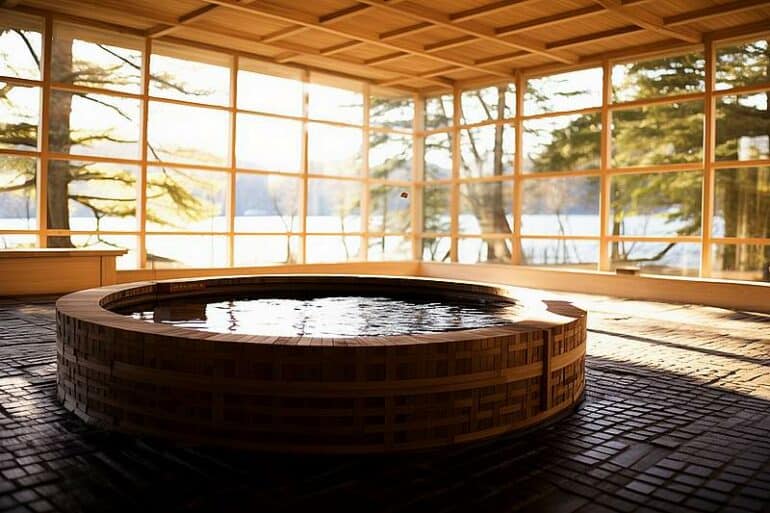Sauna in Japan – what a foreigner needs to know when visiting!
Sauna culture in Japan. Every country has its own sauna habits and traditions. In Japan, sauna culture is very different from what most people in Western countries imagine a sauna to be. Here, the Japanese “sauna,” known as furo, refers less to a steamy room and more to a hot bath. This deeply rooted tradition has a long history and has evolved over centuries.
The special wooden vats used for this bathing experience are often artfully crafted from select woods, prized not only for their durability but also for their aesthetic appeal. Once filled with hot water, these wooden vats provide an oasis of relaxation and reflection in which the Japanese immerse themselves to experience both physical and spiritual renewal.
Sauna ritual in Japan
Another typical feature of Japanese sauna culture is that sauna lovers rub their bodies with coarse-grained salt. This results in an intensive cleansing effect and increased blood circulation. The Japanese maintain their sauna culture regularly and with passion, making it a true ritual for many Japanese sauna fans. Japanese sauna customs are in some respects similar to German sauna customs, especially with regard to the form of the outdoor sauna.
Construction of the Japanese sauna
The classic Japanese sauna is characterized by a special construction method. This construction method is based on the traditional Japanese construction method. The curved gable roofs are considered a real feast for the eyes. Prefabricated kits are often used, which can be assembled relatively quickly. The outer walls are extremely thick and consist of natural tree trunks, so the heat in the interior is retained very well. Japanese sauna lovers also like to use hot springs, which can be found everywhere in the country. Already in ancient times, Japanese men and women bathed in these natural springs and thus already cultivated a certain sauna culture.
Bathhouses in Japanese temples
If you visit a Japanese bathhouse in a temple or monastery, you will discover the statue Baddabara Bosatsu. The monks first kneel on the floor and only then enter the bath. While doing so, they recite that they take the bath for the benefit of all beings. For the Japanese, the focus is not only on physical purification, but also on mental and spiritual purification.
Furo – The bath of the Japanese
While the furo is more or less the private bathtub of Japanese sauna-goers, some sauna-goers continue to use sento, the public bath, or an onsen, a natural hot spring. Whether public or private baths are used, family members all share the same water. Which additives are added to the water usually depends on the current season. For example, cherry, plum or green tea are available.
Bathing etiquette
In Japan, it is customary to wash thoroughly before entering an onsen or sento. There are often shower stalls or washing areas near the bathing area. Thorough washing before bathing ensures that the water in the onsen or sento stays clean. Soap, shampoo, and other cleaning products should be rinsed thoroughly before entering the bath.
Regional Differences
Although the basic concept of bathing is the same throughout Japan, there are small differences in bathing culture depending on the region. For example, in some regions, it is customary to wash one’s feet in a separate basin before entering a sento or onsen. In other regions, there are special bathing practices or rituals performed by locals.
Japanese sauna separately
In modern times, the private furo is used more often than the public sento. Especially on cold winter evenings, the Japanese use the shared hot sauna bath to socialize and warm up on the side. The furo, the private sauna, is available in a variety of designs, with one or more basins, different water temperatures and different seating or lounging options. The Japanese bath towel functions first as a washcloth and then as a towel. As a rule, Japanese women and men sauna separately.
The spiritual significance of water
Water plays a great spiritual role in Japanese culture. This is reflected not only in bathing culture, but also in other aspects of life, such as the many water ceremonies in temples and shrines. Water is seen as purifying, both physically and spiritually, and this deep reverence for water shapes the way Japanese treat their bathing habits.
The future of bathing culture in Japan
In recent years, there has been a renaissance of bathing culture in Japan. Traditional onsen and sento have been joined by modern “super-sento” – huge bathing complexes with a variety of bathing options, from whirlpools to saunas with different temperatures. These modern bathhouses often also offer restaurants, relaxation rooms, and other amenities that make them a popular destination for a day trip.

